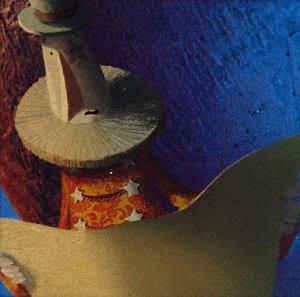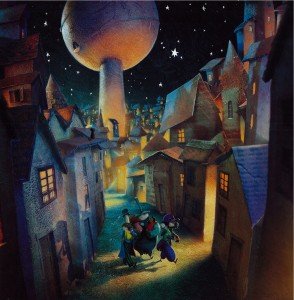Buy it, or borrow it. That’s my recommendation, and the sum of my review.
When Night Didn’t Come is beautiful, astonishingly and almost indescribably beautiful, and it belongs in the library of anyone who appreciates, collects, and occasionally slobbers over illustrated children’s books of the most exquisite quality. No, you can’t have my copy.
Poly Bernatene’s recent publication is a wordless picture book, and I’m not entirely sure I would have been able to follow the narrative without the description on the back, and of course, the title. It begins at sunset with a yawning sun. The sky darkens, but the glow remains. Where is the moon? Where is the night? And why is the sky full of dirigibles?
The centre of government in this medieval town appears to be a strange tower, like a giant globe on top of a beam of light, presided over by an angular man in an Elizabethan collar. The first to notice the absence of moonlight, he checks the phases of the moon on his rather fantastical watch, and then consults a set of scrolls depicting the events which are supposed to follow the setting of the sun. According to the plans, all the accoutrements of Night, like the stars and the moon, are housed inside the giant globe. The man runs up a set of exterior stairs on the globe, which are littered with children’s toys, finds the opening, and peers inside. Chaos. Stars scattered throughout the work room, kids in pajamas playing with levers, or perched atop a glowing crescent moon, everyone having a blast and not at all interested in the nightly task at hand. It’s not clear whether or not the kids belong here, working alongside their parents, or if they sought out this extraordinary place. Certainly beats a sandbox.
Judging by the man’s expression, some hollering ensues, and the crew springs into action. A fellow looking very much like the Artful Dodger leads the way, jumping on his strange bike attached to a dirigible. Soon, the stars have been released to the sky and the moon has been hung. The sleeping children are taken home through the winding streets of the village. The following day, a young boy awakens, and in a series of increasing close-ups, the illustrations zero in on the child’s face until there is nothing but his iris, with the village and the globe-like tower reflected in his eyeball. Got it. This was a dream. I think. But if so, what a dream.
The format of the book switches from comic book panels to full and double page spreads. There is some obvious computer involvement in Bernatene’s illustrations, especially vivid in the textural backgrounds and in the foreground shadows, and perhaps in some not so obvious areas, but the combination of old school illustration and sophisticated image manipulation is a picture book exploding with brilliant colour and wildy imaginative visual storytelling. The country is indistinct, as is the era, and maybe even the planet. The adults seem to be from a different century than the contemporarily dressed children, and yet the narrow, cobble-stoned streets and the peaked roofs of the village suggest a medieval setting. Ultimately, it doesn’t matter. The questions left unanswered and the unspoken text only deepens the wonder of this book.
My introduction to Argentinian artist Poly Bernatene was a mere two months ago via Canada Post, when The Santa Trap arrived in the mail, ordered online based solely on the cover. Bernatene has published many books, and it is my intention to find a spot on my bookshelf for all of them, eventually, even if I have to kick a few lesser books to the door.
However, even in my limited experience with the Bernatene oeuvre, I see similarities in stylistic choices; in particular his fascination with bizarre machinery, comically tiny feet, and of course, colours so rich they seem otherworldly. I also see the the influence of Lane Smith (The Very Persistent Gappers of Frip), and for shared breadth and strangeness of artistic vision, the great Shaun Tan. There may even a bit of a retro nod to Edmund Dulac’s The Entomologist’s Dream in the sapphire blue of the Bernatene’s globe. Well, perhaps it’s a stretch, but some blues are hard to forget.
Poly Bernatene was born in 1972, in Buenos Aires, Argentina where he graduated from the Buenos Aires Art School. He has worked in advertising, animation, and comic books, eventually establishing a highly prolific and rather daunting career in children’s book illustration, with more than 60 books under his belt, so far.
Mr Bernatene also has a great website, which is entirely in Spanish. Interesting note: I used Google Translator to translate his words into English. Bernatene’s book Tita, La Planta Maldita translates (apparently) into Tita, Damn Plant. Hmm. Either it lost something in translation or the children’s book industry in Argentina is way more progressive than ours. And angrier. In that spirit, may I say When the Night Didn’t Come is one damn fine book. No translation required.
When Night Didn’t Come by Poly Bernatene, published by Meadowside Children’s Books, 2010
The Santa Trap by Jonathan Emmett , illustrations by Poly Bernatene. Published by Macmillan UK, 2009






Oh yes on yes oh yes! This is a book I treated myself to a few months back – I know nothing of Argentinian kidlit and when i saw this, and saw that it was wordless I had to get it. I agree with you that the illustrations are breathtaking. I also agree with you that “I’m not entirely sure I would have been able to follow the narrative without the description on the back,” and this is precisely why I haven’t yet reviewed it on my blog. Although I love narratives that are complex and reward repeated visits (especially with children’s books where repeat visits are often the order of the day) when we first “read” this book together both the girls and I found it quite difficult to piece together the story. We had to work quite hard – and perhaps a little too hard, dare I say as it’s not been a book the girls have voluntarily returned to yet. I don’t really want to admit all this as I agree with you that everyone should somehow get a copy to read for themselves and so I don’t want this comment to sound negative. Maybe this is a case of a wordless book best suited for older kids (again like several of Shaun Tan’s books), and as such is a little difficult to sell. I haven’t seen any more work by Bernatene but I’m definitely on the look out!
[…] a good review of it here. I like that the review was made by someone who also collects children’s […]